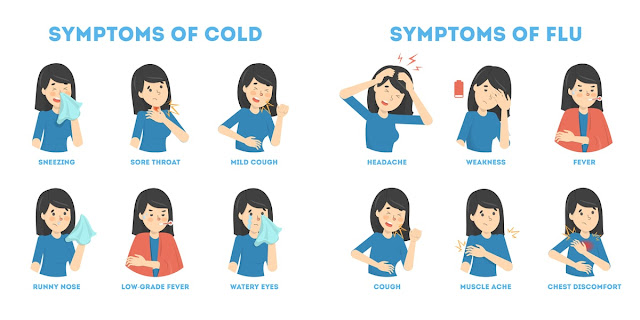When you wake up with
an achy throat, coughing, wheezing or a feverish feeling, how do you find out
if these are cold symptoms or you have the flu? It is essential to know the difference
between flu and cold, before taking flu relieving capsules
or any common cold treatment.
Basic Difference between Flu and Cold
What It Is?
Cold is a respiratory
disease, but it is milder than the cold. Although cold symptoms can make you
feel sick for quite a few days, flu can also result in serious health repercussions,
such as hospitalization and pneumonia.
Symptoms
Cold symptoms include
a sore throat that continues for a day or two, accompanied by congestions,
nasal blockages, runny nose and coughing that persists to the fourth and fifth
day. Adults can also get a slight fever, but children are much more likely to
develop a high fever with the cold.
When you have a cold,
the nasal cavity fills with watery nasal secretions that get thicker as well as
darker within a few days. It is not a cause for concern as dark mucus is natural
and doesn’t mean that you have a bacterial infection like a sinus infection.
Flu on the other hand,
is much more severe than a mere cold. And while flu relieving syrup
may seem like the ultimate answer, it is necessary to understand its symptoms.
The flu symptoms include fever, muscle aches, headaches, sore throat, sore
muscles, cough and congestion. Some strains of flu such as swine flu also
results in diarrhoea and vomiting.
How Long Does It Last?
Cold symptoms can last
roughly for about a weekend if they don’t seem to improve within a week you
will need antibiotics to get better. During the first three days of having a
cold, you remain contagious, meaning you can pass on the cold to others. Therefore,
it is better to stay at home and have as much rest as necessary.
Flu gradually improves
within 2-5 days, but it is not uncommon for a flu patient to feel run down even
after taking flu relieving capsules. If a flu gets severe, patients, especially
the elderly or patients with lung or heart problems, can develop pneumonia and
shortness of breath.
Take Your Temperature
Before deciding
between cold and flu powder
as common cold treatment or treatment for flu symptoms, understanding and
identifying the difference is very important. According to most exerts, taking
your temperature will help.
Flu symptoms usually
mimic the cold symptoms like malaise, coughing, aches and congestion. However,
a common cold will rarely have a fever above 101 degrees, while flu will initially
start with a fever.

Comments
Post a Comment